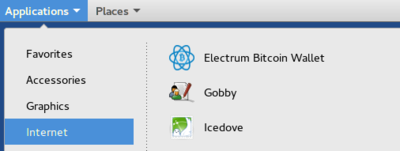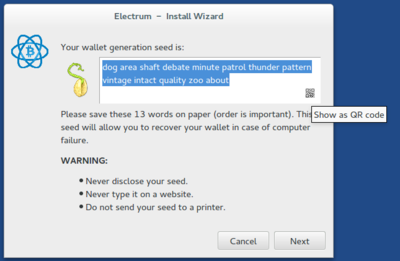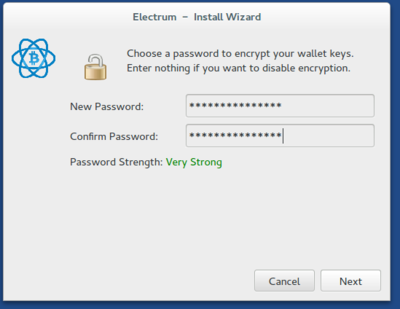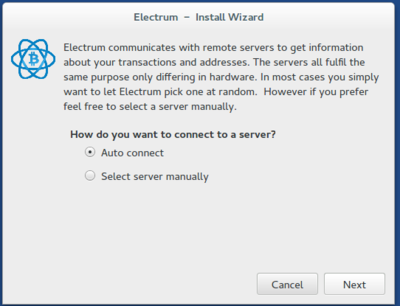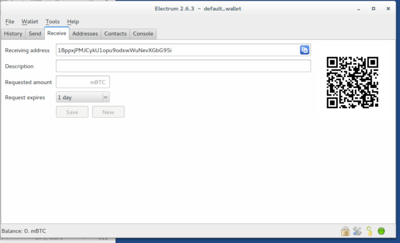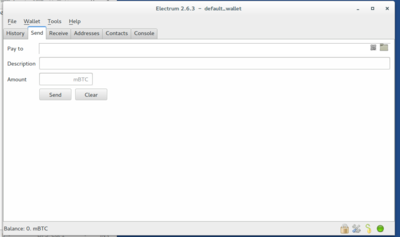Difference between revisions of "Cryptocurrency (Buying things anonymously)"
From Gender and Tech Resources
(→Introduction) |
(→Introduction) |
||
| Line 41: | Line 41: | ||
-> Irreversible payments: Confirmed transactions can not be modified or eliminated. The story is unforgettable. | -> Irreversible payments: Confirmed transactions can not be modified or eliminated. The story is unforgettable. | ||
| − | You can watch the following video to see how a mining farm of bitcoins looks like in China | + | You can watch the following video to see how a mining farm of bitcoins looks like in China |
| − | https://vimeo.com/141600878 | + | {{#ev:vimeo|https://vimeo.com/141600878}} |
==¿Qué necesitas?== | ==¿Qué necesitas?== | ||
Revision as of 17:09, 1 February 2017
Contents
Introduction
A cryptomoney is a type of currency that allows economic exchanges, and which is characterized by being stored electronically and incorporates encryption for security of transactions. Intuitively we can think of cryptomoneys as digital coins, however because of the technology they incorporate and their functioning they are not equivalent. Cryptomoney can serve, like conventional currencies, to buy products or pay for services.
There is no consensual definition, wikipedia tell us the following:
A cryptocurrency (or crypto currency) is a digital asset designed to work as a medium of exchange using cryptography to secure the transactions and to control the creation of additional units of the currency. Cryptocurrencies are a subset of alternative currencies, or specifically of digital currencies. Bitcoin became the first decentralized cryptocurrency in 2009. Since then, numerous cryptocurrencies have been created. These are frequently called altcoins, as a blend of bitcoin alternative. Bitcoin and its derivatives use decentralized control as opposed to centralized electronic money/centralized banking systems. The decentralized control is related to the use of bitcoin's blockchain transaction database in the role of a distributed ledger [2]
There are different types of criptomoneys but they have in common that their value is determined by the supply and the demand and that in principle they are not falsifiable (even tough this does not prevent always fraud exists, see for example the case of OneCoin[3]).
Broadly speaking, we can trace the birth of cryptomonedas as part of the criptopunk movement that appealed to the use of cryptography as a tactic for social change. One of the first electronic coins was Digicash launched in 1990 by David Chaum, this centrally-operated currency already incorporated encryption and allowed electronic transactions[4].
Seven years later Adam Black proposed Hashcash a mining system that uses a proof-of-work algorithm work (POW [5]) originally used to limit spam (unwanted mail) and denial of service (DoS) attacks and which would be later incorporated into cryptomoenys. In 2009, an unknown identity under the pseudonym Satoshi Nakamoto published Bitcoin which is one of the most used cryptomoneys and that we will use to develop this How to.
Bitcoin is characterised by [6]:
-> A decentralized p2p network (the bitcoin protocol)
-> Transactions are public (the block chain)
-> A decentralized deterministic coin and mathematical emission (distributed mining)
-> A decentralized transaction verification system (transaction script)
Currently it has the following fundamental principles [7]:
-> 21 million: the number of units will never exceed 21 million bitcoins.
-> Uncensored: no one can ban or censor valid transactions.
-> Open source: Bitcoin's source code should always be accessible to everyone.
-> Without permission: nobody can prevent participation in the network.
-> Pseudonym: no identification is required to participate in the Bitcoin network.
-> Fungible: each unit is interchangeable.
-> Irreversible payments: Confirmed transactions can not be modified or eliminated. The story is unforgettable.
You can watch the following video to see how a mining farm of bitcoins looks like in China
¿Qué necesitas?
Un USB persistente de Tails
¿Cómo puedo usar bitcoins para comprar anónimamente?
Para poder hacer transacciones con Bitcoin se necesitas tener una dirección (con la cual podrás recibir o enviar Bitcoins) y llaves, con las cuales tus transacciones serán firmadas, al conjunto de llaves se le conoce como Billetera.
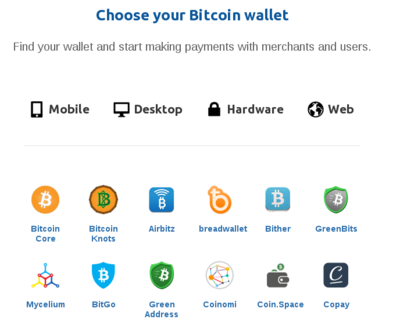
Bitcoin cuenta actualmente con una gran cantidad de billeteras que pueden funcionar como programas, aplicaciones para celular e incluso como dispositivos.
Si bien Bitcoin incorpora a su sistema el cifrado para lograr anonimato en las compras requiere que las transacciones no puedan ser asociadas con tu identidad legal. Esto no es tan simple , puedes ver más información en: https://en.bitcoin.it/wiki/Anonymity (en inglés). En nuestro caso vamos a usar al billetera que viene en TAILS por defecto: Electrum [9].
5 pasos para crear una billetera en TAILS
1) En Aplicaciones vas a Internet y abres Electrum Billetera Bitcoin
2) Sigues el proceso seleccionando crear una nueva billetera de forma estándar
3) El programa de creación de billetera te genera 13 palabras y te sugiere copiarlas en un papel o usar un código QRT. Puedes elegir el que prefieras pero para el código QRT necesitaras además un programa que lea este tipo de código.
4) Te pedirá una contraseña (usa una fuerte)
5) El programa te preguntará si se autoconecta o si prefieres hacerlo de forma manual, puedes seleccionar con el que prefieres.
6) Tu billetera fue creada. Ahora tienes direcciones -notar que tienes 20- para recibir depósitos y puedes hacer transacciones con otros enviando Bitcoins si conoces las direcciones de envío.
Agregando Bitcoins a tu billetera
Existen diferentes formas para hacer que tu billetera reciba bitcoins, en nuestro caso para poder hacerlo anónimamente sugerimos buscar alguna organización intermediaria que se dedique a la transferencia de bitcoins y que te permita hacer un depósito en una banco que cuente con cajeros automáticos que no te obligaran a asociar el depósito a una identidad legal personal (Por ejemplo [10] . Este tipo de organizaciones funcionará como un intermediario, te proporcionará una cuenta de depósito y ellos te harán llegar los bitcoins a tu monedero. otra forma es a través de una organización intermediaria hacer uso de depósito instantáneos como el de MoneyPolo[11] .
Hacer tu compra
Al igual que en otro tipo de transacciones electrónicas lo que requieres es que te indiquen a dónde se va a enviar los bitcoins (dirección de envío) y lugares en los que te acepten este tipo de moneda, por ejemplo es posible pagar con bitcoins dominios, productos electrónicos, servicios, puedes tener algunas ideas en: https://en.wikipedia.org/wiki/OpenBazaar (en inglés).
Notas finales
Recuerda que todas las transacciones son públicas así que para evitar se relacionen direcciones con compras puedes hacer depósitos de cantidades menores de bitcoins y transferencias igualmente de cantidades menores.
También debes recordar que los cajeros tienen cámaras y ahora es cada vez más fácil el reconocimiento facial a través de imágenes.
Por último infórmate, hay países en los que es ilegal el uso de Bitcoins.
Referencias
- ↑ ASCII de una moneda del siglo VI a. C. 1/3 de Estátera.
- ↑ https://en.wikipedia.org/wiki/Cryptocurrency
- ↑ https://steemit.com/money/@morpheustitania/onecoin-is-a-scam
- ↑ https://en.wikipedia.org/wiki/DigiCash
- ↑ https://en.wikipedia.org/wiki/Proof-of-work_system
- ↑ http://chimera.labs.oreilly.com/books/1234000001802/ch01.html#_what_is_bitcoin
- ↑ https://en.wikipedia.org/wiki/Blockchain_%28database%29
- ↑ https://bitcoin.org/en/choose-your-wallet
- ↑ https://electrum.org/#home
- ↑ https://www.territoriobitcoin.com/como-comprar-bitcoin-en-bitboat-tutorial/
- ↑ https://moneypolo.com

